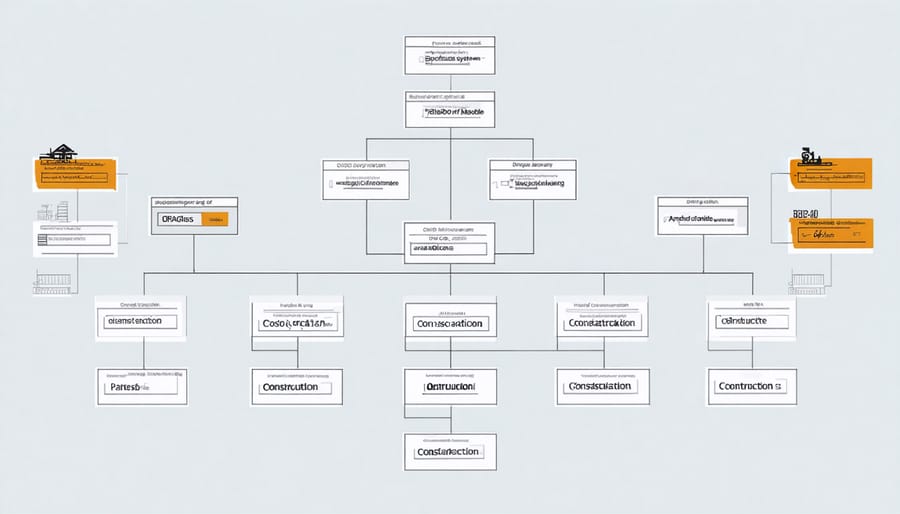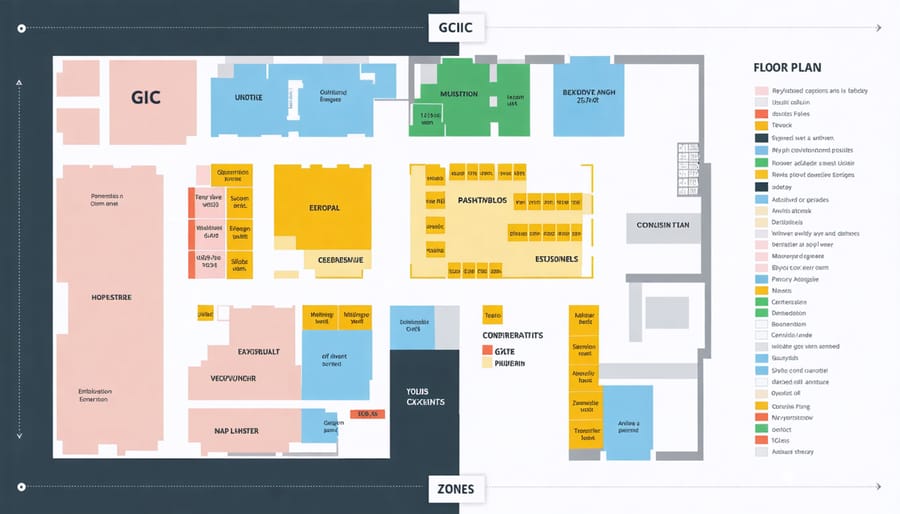Transform your construction industry events with GICS (Global Industry Classification Standard) classifications to create targeted, high-impact networking opportunities. This standardized framework, trusted by leading industry associations, segments the market into 11 sectors, 24 industry groups, and numerous sub-industries, enabling precise attendee categorization and strategic event planning.
For construction professionals, GICS classifications provide essential structure for organizing sector-specific conferences, identifying potential collaboration partners, and analyzing market trends across related industries. From Real Estate Development (60) to Capital Goods (2010), these standardized categories ensure meaningful connections between stakeholders while maintaining clear business intelligence frameworks.
Understanding GICS industry groups empowers construction leaders to make data-driven decisions about market positioning, competitive analysis, and strategic partnerships. This systematic approach to industry categorization has become particularly crucial as construction technologies evolve and traditional sector boundaries blur, requiring more sophisticated methods of market segmentation and professional networking.
GICS Classification Framework in Construction Events

Key Construction-Related GICS Groups
The construction sector encompasses several key GICS industry groups that professionals should monitor to stay ahead of construction industry trends. The Capital Goods industry group (2010) is particularly significant, including construction machinery, building products, and construction & engineering companies. This classification encompasses major contractors, equipment manufacturers, and materials suppliers essential to construction projects.
The Real Estate industry group (6010) is another crucial category, covering real estate development companies, REITs, and property management firms that drive construction demand. The Materials industry group (1510) includes construction materials manufacturers and suppliers, particularly those producing cement, concrete, and other building materials.
Construction professionals should also monitor the Consumer Durables & Apparel group (2520), which includes home builders and manufacturers of household durables. The Commercial & Professional Services group (2020) is relevant for construction consulting firms and project management services.
Understanding these GICS classifications helps construction professionals:
– Identify potential business partners and suppliers
– Track market movements affecting construction activity
– Analyze competition within specific market segments
– Make informed investment decisions
– Develop strategic partnerships across the construction value chain
These industry groups provide a framework for understanding market dynamics and help construction professionals position their organizations effectively within the broader construction ecosystem. Regular monitoring of these groups can reveal emerging opportunities and potential challenges in the construction sector.
Cross-Industry Networking Benefits
The strategic implementation of GICS classifications has revolutionized how construction industry professionals connect and collaborate across sectors. By providing a standardized framework for categorizing businesses, GICS enables meaningful cross-industry collaboration that drives innovation and growth.
Construction companies can leverage GICS groupings to identify potential partners, suppliers, and clients across related sectors such as Real Estate, Materials, and Industrial Equipment. This systematic approach helps organizations pinpoint complementary businesses that share common challenges, regulatory environments, or market dynamics.
For example, a commercial construction firm specializing in healthcare facilities can use GICS classifications to connect with healthcare REITs, medical equipment manufacturers, and facilities management companies. These connections often lead to more comprehensive project solutions and enhanced value delivery for clients.
The standardized nature of GICS also facilitates more effective industry events and networking opportunities. Event organizers can structure sessions and matchmaking activities based on GICS groupings, ensuring participants connect with the most relevant potential partners. This targeted approach significantly improves the ROI of networking activities and industry conferences.
Furthermore, GICS-based networking enables construction professionals to stay informed about broader market trends and innovations that may impact their sector. By maintaining relationships with companies in adjacent industries, organizations can better anticipate market shifts and adapt their strategies accordingly, creating a more resilient business model in an increasingly interconnected economy.

Strategic Event Planning Using GICS Categories
Target Audience Segmentation
The GICS framework provides event organizers with a powerful tool for precise audience segmentation, particularly within the construction and infrastructure sectors. By leveraging GICS classifications, organizers can identify and target specific industry segments such as Capital Goods, Construction Materials, and Construction & Engineering professionals.
For optimal attendee targeting, event planners should focus on primary GICS sectors like Industrials and Materials, then drill down to industry groups that align with their event objectives. This approach enables more effective outreach to key decision-makers across various construction specialties, from commercial builders to infrastructure developers.
Creating attendee personas based on GICS classifications helps in developing targeted marketing messages and programming. For instance, professionals from the Building Products industry group may have different interests and needs compared to those from the Construction Machinery segment. Understanding these distinctions allows for more personalized event experiences and networking opportunities.
Event organizers can also use GICS data to:
– Identify potential sponsors within relevant industry groups
– Structure breakout sessions based on sub-industry interests
– Create targeted networking opportunities among complementary sectors
– Develop marketing materials that resonate with specific industry segments
By aligning event planning with GICS classifications, organizers can ensure their gatherings attract the most relevant attendees while fostering meaningful industry connections and knowledge exchange.
Exhibitor Organization Strategies
Organizing exhibition spaces according to GICS classifications creates a logical flow that enhances attendee experience and facilitates meaningful industry connections. Construction event planners can leverage GICS industry groups to create distinct zones that mirror the natural segmentation of the construction ecosystem.
Primary exhibition areas should be arranged following the main GICS sectors relevant to construction, such as Capital Goods, Materials, and Real Estate. Within these broader sections, sub-zones can be established based on industry groups. For example, the Capital Goods section might feature dedicated areas for Construction Machinery, Building Products, and Construction & Engineering firms.
This systematic approach enables exhibitors to position themselves alongside complementary businesses, fostering strategic partnerships and business development opportunities. Visitors benefit from intuitive navigation and efficient networking, as they can easily locate relevant vendors and industry peers within their specific sector.
Leading construction trade shows have successfully implemented this strategy by color-coding different zones and providing digital wayfinding solutions based on GICS classifications. Interactive floor plans and mobile applications help attendees plan their routes effectively, while clear signage and zone markers ensure seamless navigation throughout the exhibition space.
Event organizers should consider creating intersection points between related GICS groups to encourage cross-sector collaboration and innovation. These networking hubs can serve as meeting points where professionals from different industry groups can connect and explore potential synergies.

Association Management Through GICS Framework
Industry associations have revolutionized their member management and strategic planning through the effective implementation of the GICS framework. By leveraging GICS classifications, associations can better organize their membership base, tailor programming, and facilitate more meaningful connections among industry participants.
For construction industry associations, GICS provides a standardized approach to categorizing members across various subsectors, from heavy construction firms to building products manufacturers. This systematic organization enables associations to develop targeted initiatives that address specific challenges faced by different segments within the industry, particularly in emerging construction markets.
The framework’s hierarchical structure allows associations to:
– Create focused working groups and committees based on specific industry segments
– Develop specialized training programs aligned with sector-specific needs
– Organize networking events that bring together complementary business interests
– Track industry trends and performance metrics across different subsectors
Many associations have implemented GICS-based member directories, enabling participants to quickly identify potential partners, suppliers, or clients within their specific industry segment. This targeted approach has proven particularly valuable for large industry events, where attendees can efficiently connect with relevant stakeholders.
Furthermore, associations utilize GICS classifications to:
– Design more relevant educational content
– Structure mentorship programs between established and emerging companies
– Distribute industry-specific updates and regulatory information
– Coordinate advocacy efforts for sector-specific issues
By adopting GICS as an organizational framework, industry associations have significantly improved their ability to serve members while promoting more efficient collaboration within the construction sector. This structured approach has become increasingly important as the industry continues to evolve and specialize.
In today’s rapidly evolving construction landscape, GICS has proven to be an invaluable framework for organizing and maximizing the potential of industry events. By providing a standardized classification system, GICS enables event organizers to create more targeted networking opportunities, facilitate meaningful business connections, and streamline the exchange of sector-specific knowledge. Construction professionals who understand and leverage GICS classifications gain a significant advantage in identifying relevant partnerships, tracking market trends, and positioning their businesses within the broader industry ecosystem. As the construction sector continues to embrace digital transformation and sustainable practices, GICS remains a crucial tool for ensuring events deliver maximum value to attendees and stakeholders while fostering innovation and growth across the industry. Moving forward, construction companies that align their event strategies with GICS frameworks will be better equipped to navigate market challenges and capitalize on emerging opportunities.

